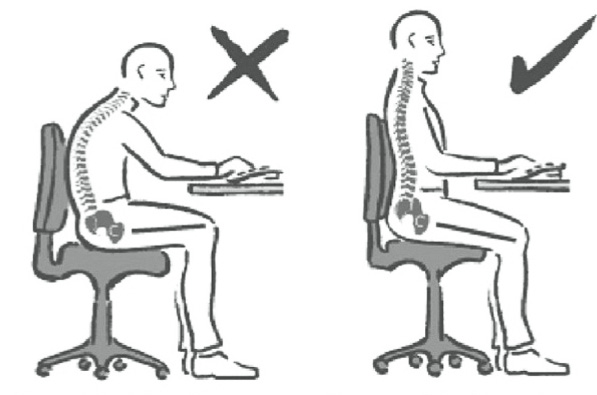Sit on your sit bones

Introduction to Ms Josephine Key
Ms Josephine Key has over 40 years of clinical experience in
neuromuscular-skeletal physiotherapy. Josephine’s work distils academic evidence
into her practice. With her deep experience, Josephine wrote a text book,
Back Pain: A Movement Problem
(2008 Elsevier Edinburgh), and then a second book,
Freedom to Move: Movement therapy for spinal pain and injuries
(2018 Handspring Edinburgh).

The sedentary working life of a barrister can result in us experiencing back pain and other issues. Josephine gave a presentation for the New South Wales Bar on 18 February 2021 concerning Movement, which was very insightful. Josephine has written the following piece emphasising the significance of sitting properly for a healthy spine and general wellbeing.
Primitive man was active as a hunter gatherer. The barrister is at the opposite end of the spectrum. Instead of a diverse array of movement, barristers may spend most of their waking hours sitting. HOW YOU SIT is the difference between helping or hindering a healthy spine and musculoskeletal system and many of our internal functions—breathing, CORE support for postural control, digestion, continence and so on.
The basis of healthy movement is effective postural control. It is all about how you deal with gravity. This is effectively achieved in the process of our motor development. However, modern industrial society has changed our posturo-movement behaviour.
So, let’s look at the SPINE. It is a column which supports the body vertically against gravity and a basis for movement. In upright postures it is happiest in the vertical position where the segments are loaded ergonomically in an energy efficient manner—this also optimises the breathing and core control mechanisms. One of the reasons that many modern humans have such a weak CORE is that they are so inactive. However, if you adopt an upright sitting posture, this can quite effectively activate your CORE.
Upright support of the SPINE is dependent on the position and control of the Pelvis.
And this is all about your SIT BONES! It is that simple. If I can say one thing: SIT ON YOUR SIT BONES—It’s ‘the elusive obvious’. 1 The simple truth to a healthy spine is knowing where your SIT BONES are, where you place them and what you do with them. This involves being mindful. 2

I imagine, but do not know, that most barristers are habitually falling off the back of their SIT BONES. I know it is the case with many of the thousands of patients I have seen. This means that the SPINE becomes a bent rod rather than an erect column. This creates, over time, stress and strain patterns on the joints and soft-tissues—the discs, the nerves, the muscles. This in turn leads to the development of stiffness, back pain, back spasms—and also many injuries. I imagine there may be a few barristers on the way to developing such problems or with such problems.

Most people fall back off their SIT BONES and the SPINE collapses. In order to support it upright, the Pelvis needs to tip forward which means rocking forward onto the front part of your SIT BONES.
Sitting with one leg crossed over the other, with your feet up on a stool or on a desk means the barrister cannot be sitting on their SIT BONES.
Sitting on your SIT BONES helps re-establish your CORE.
Your CORE is not what you might think it is. I imagine some barristers might think their CORE is the barrister’s six-pack. Your CORE is much deeper than that. It is the natural mechanism by which the SPINE achieves internal support and how this is coordinated with breathing and other things, like continence etc.
I imagine a barrister or two has been falsely advised that training your CORE involves sit ups and crunches and other strenuous abdominal exercises. Rather, your CORE involves complex coordination between your diaphragm, your pelvic floor and the deepest abdominal muscles called the Transversus Abdominus. It is about what is inside and how the pressure change mechanisms are controlled. Most so-called core training involves the outer abdominals. Yet if these muscles are too strong and tight, they can interfere with your internal CORE. 3 In your worktime you can be doing something about training your CORE. I believe it all relies on HOW YOU SIT. If you sit well, it’s easier to breathe properly and also train your CORE naturally. If you collapse, you are switching off your CORE and unwittingly contributing to many other problems.
Healthy sitting and CORE control involve mindful attention and awareness of the inner self.
May I say one thing again: SIT ON YOUR SIT BONES and be mindful of checking that throughout the day. Eventually a habit of sitting on your SIT BONES will emerge!
ENDNOTES
1 This is the expression of the famous somatic educator—Moshe Feldenkrais .
2 We are coming to appreciate the significance of mindfulness, including in movement control and self-regulation of stress. Connected with this are usually problems with Sleep and breathing. I understand that sleep and Breathing are two topics that the Wellbeing Committee will bring to the NSW Bar.
3 Key. J. ‘The core’: Understanding it, and retraining its dysfunction,The Journal ofBodywork and Movement Therapies (2013) .